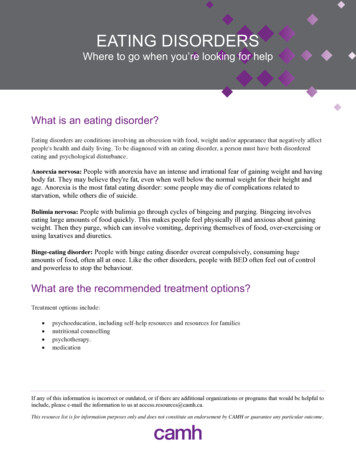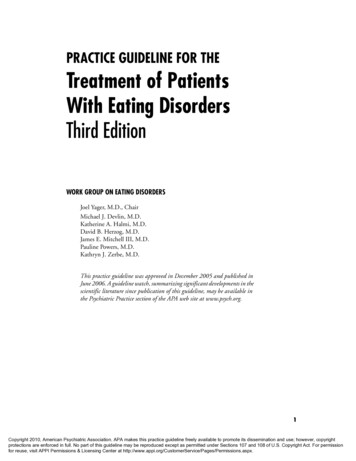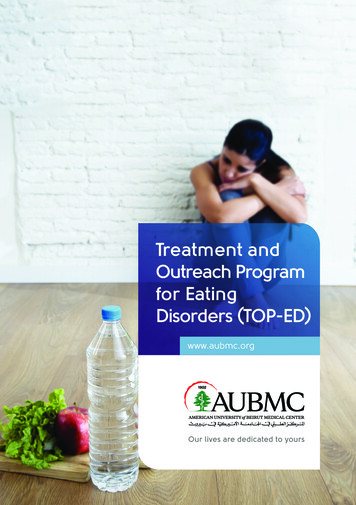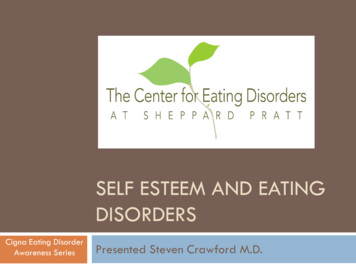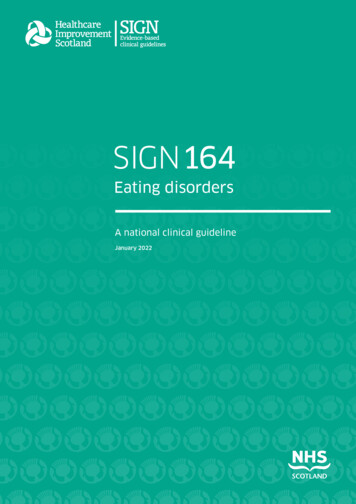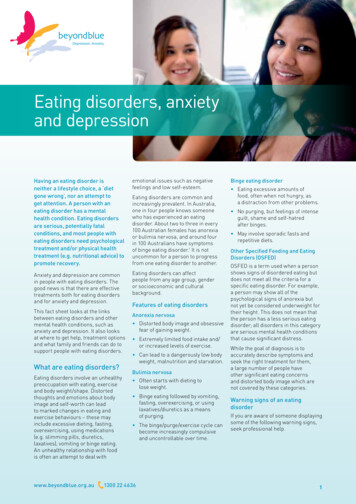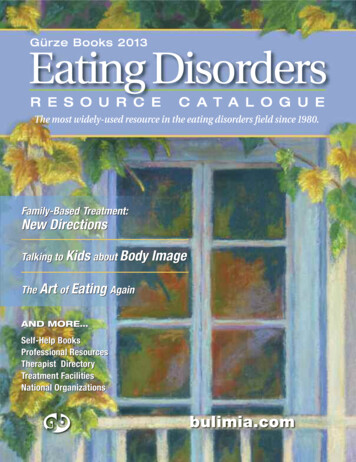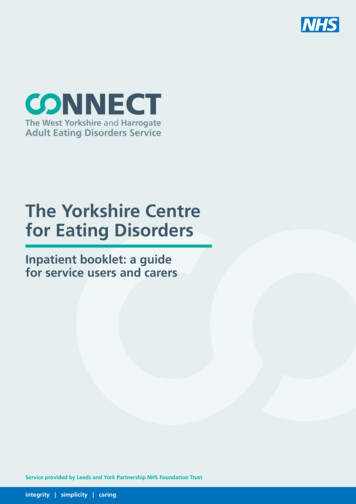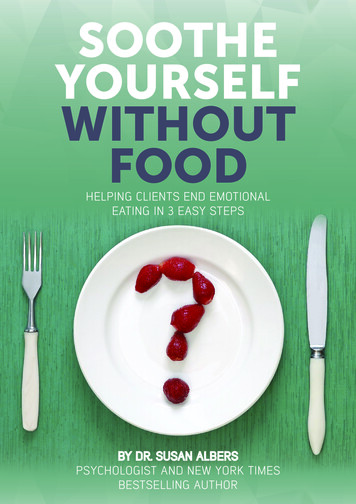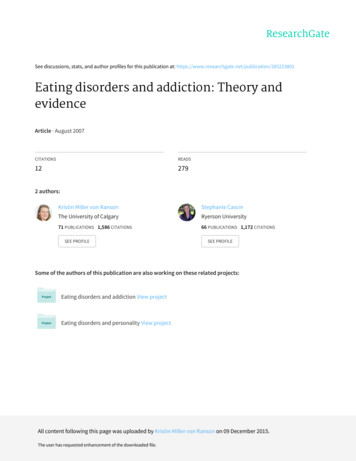
Transcription
See discussions, stats, and author profiles for this publication at: Eating disorders and addiction: Theory andevidenceArticle · August 2007CITATIONSREADS122792 authors:Kristin Miller von RansonStephanie CassinThe University of CalgaryRyerson University71 PUBLICATIONS 1,586 CITATIONS66 PUBLICATIONS 1,172 CITATIONSSEE PROFILESEE PROFILESome of the authors of this publication are also working on these related projects:Eating disorders and addiction View projectEating disorders and personality View projectAll content following this page was uploaded by Kristin Miller von Ranson on 09 December 2015.The user has requested enhancement of the downloaded file.
Eating disorders and addictionEating disorders and addiction: Theory and evidenceIn press (April 2005),P. I. Swain (Ed.), Trends in Eating Disorders ResearchHauppauge, NY: Nova Science PublishersKristin M. von Ranson, Ph.D. & Stephanie E. Cassin, M.Sc.Department of Psychology, University of Calgary1
Eating disorders and addiction2ABSTRACTA substantial gap exists between scientific evidence and clinical practice in the psychologicaltreatment of eating disorders. Not only are eating disorders commonly described as addictions bylaypersons and mental health professionals alike, but surveys indicate that approximately 30% ofeating disorder treatment programs and clinicians use addictions-based psychotherapies to treateating disorders. However, the validity of the addiction model of eating disorders has receivedlittle empirical study and the efficacy of addictions-based psychotherapies for eating disordersremains untested. Understanding the extent of associations between eating disorders andaddictions has important implications for treatment, prevention, and our understanding of theetiology of eating disorders. This chapter examines issues surrounding the definition ofaddiction, reviews theoretical reasoning and empirical evidence regarding the addiction model ofeating disorders, and in this context, discusses the construct of “addictive disorder” and identifiesfuture research directions.
Eating disorders and addiction3INTRODUCTIONA large, sometimes conflicting literature on associations between eating disorders andaddictions—sometimes also termed addictive behaviors or disorders—has developed in recentyears. A number of reviews of the conceptualization of eating disorders as forms of addictionhave been prepared (e.g., Bemis, 1985; Vandereycken, 1990; Wilson, 1991; Wilson, 1993;Wilson, 1999; Wilson, 2000, 2002; Wilson & Latner, 2001). After critically examining empiricaland theoretical support for the “addiction model” of eating disorders,1 these reviews havegenerally concluded that neither convincing empirical support nor sound theoretical basis existsfor conceiving of eating disorders as addictions. To many researchers, it is a given thatconceiving of or treating eating disorders as addictions is unfounded. It is striking, however, thatothers persistently contend that addictions-based treatment approaches for eating disorders havemerit. For example, clinicians have adapted psychotherapeutic strategies from existing addictionstreatments for individuals with eating disorders (e.g., Johnson & Sansone, 1993; Johnson &Taylor, 1996; McAleavey & Fiumara, 2001; Riley, 1991; Trotzky, 2002; Weiner, 1998). Thisongoing contradiction between research-based recommendations and actual clinical practicesuggests a need to carefully re-examine the topic of the addiction model of eating disorders.Despite a great deal of empirical interest in certain questions related to the addictionmodel of eating disorders, such as the degree to which eating disorders co-occur with such coreaddictions as substance abuse, many facets of this model remain unexamined. The dearth ofempirical investigation into many aspects of the addiction model of eating disorders may be, inpart, due to the absence of systematic information on the frequency of use of addictions-based1Although mention is made here and elsewhere in the literature of an “addiction model” of eating disorders as ifthere is only one, in fact there are variations, as is discussed later in this chapter. These addiction models have incommon an emphasis on the apparent addictive nature of eating disorder symptoms. For simplicity, we use the term“addiction model” in this chapter to refer to those theories or views of eating disorders that focus on the centrality ofaddictive elements in the etiology of the eating disorder, its maintenance, or both.
Eating disorders and addiction4approaches in the treatment of eating disorders. In other words, it has not been clear in practicalterms just how significant an issue the addiction model of eating disorders really is. Untilrecently, no published studies described the frequency of use of addictions-based approaches.However, results of a recent telephone survey demonstrated that more than a quarter (26.9%) ofpsychotherapists in a large Canadian city who regularly provided services to individuals witheating disorders often or always folded addictions-based approaches into their eating disordertreatment, and an additional 15.4% of psychotherapists referred clients to adjunctive addictionsbased treatments (von Ranson & Robinson, in press). Thus, close to half (42.3%) of thesepsychotherapists either used or promoted services with addictions-based eating disordertreatments, indicating that some form of the addiction model of eating disorders is widelyembraced by clinical practitioners.It would be time-consuming and quite challenging—perhaps prohibitively so—to obtaincomprehensive information about the psychotherapeutic orientations of treatment programs thattreat individuals with eating disorders, particularly those available across a wide range oflocations. However, the advent of the internet provides an opportunity to describe thosetreatment programs that have web pages. Between October and December 2004, we conducted asystematic survey of English-language internet websites advertising or describing treatmentservices emphasizing eating disorders to determine what proportion included an addictionscomponent.2 This survey identified 177 eating disorder treatment program sites; of theseprograms, 54 (30.5%) used an addictions-based approach, including 12-step programs, as part or2The search engine used was www.google.ca. Search terms included combinations of “eating disorder,” “anorexia,”and “bulimia” with “treatment,” “addiction,” and “12-step.” As search results yielded very large numbers of hits(e.g., 2,620,000) and later results tended to be repetitions of previously visited sites or sites that yielded noadditional information, not all search results were examined. Instead, the first 100 “eating disorder treatment”websites were examined as well as the first 50 results from the remaining searches. Websites were excluded fromthis analysis if (1) they were written in a language other than English or (2) did not mention eating disorders as oneof six major problems treated, suggesting a lack of specialization in eating disorders treatment.
Eating disorders and addiction5all of their treatment of an eating disorder. Addictions-based treatment programs were locatedprimarily across the United States (87.0%), but sites were also identified in Canada (5.6%), theUnited Kingdom (5.6%), and South Africa (1.9%). Although the eating disorder treatmentwebsites identified are unlikely to constitute a representative sample of eating disorder treatmentprograms in these locations, it is important to note that the present internet-based findings arequite consistent with those found in the telephone survey described above, which described thepsychotherapeutic orientation of psychotherapists in Calgary, Canada (von Ranson & Robinson,in press). Taken together, these survey findings suggest that addictions-based treatmentapproaches for eating disorders are widespread across North America and are used byapproximately 30% of eating disorder treatment programs and practitioners.Consistent with these findings, eating disorders are also commonly considered addictionsby laypersons. Addictions-based self-help treatments for eating disorders, most prominentlyOvereaters Anonymous (e.g., Ronel & Libman, 2003), are commonplace across North America.We describe and discuss the tenets of Overeaters Anonymous in detail later in this chapter.Another important reason to study the validity of the addiction model of eating disordersis that implications for treatment vary dramatically according to differing etiological andconceptual models of eating disorders. For example, cognitive behavioral therapy, widelyaccepted as the most efficacious treatment for bulimia nervosa (e.g., Fairburn, 2002; ThompsonBrenner, Glass, & Westen, 2003; Wilson & Pike, 2001), is based on a model that emphasizes therole of both cognitive and behavioral factors in the maintenance of eating disorders. Thecognitive-behavioral model of bulimia nervosa asserts that when women overvalue weight andshape and restrict their food intake in order to achieve the sociocultural ideal of beauty, somebecome vulnerable to periodic loss of control over eating (Wilson & Pike, 2001). Purging and
Eating disorders and addiction6other compensatory behaviors are used to compensate for the effects of binge eating, but alsohelp maintain binge eating by reducing anxiety about potential weight gain and disruptinglearned satiety signals that regulate food intake, both of which contribute to future binge eating(Wilson & Pike, 2001). Cognitive-behavioral treatment of bulimia nervosa centers on reducingdietary restraint and maladaptive attitudes about the significance of weight and shape,establishing regular, nutritionally balanced meals, and introducing previously avoided foods intoa more flexible diet (Wilson & Pike, 2001).In contrast, a prominent addiction model of eating disorders asserts that “food addiction”results from a physiological, biochemical condition of the body that creates cravings for refinedcarbohydrates and other food substances (Sheppard, 1993), such that the patient depends on andis unable to control his or her intake of certain food substances (Haddock & Dill, 1999).Following from this model, treatment of food addiction requires highly structured eating patternsand absolute abstinence from specific “addictive” foods, such as white flour and sugar (Yeary,1987). Note that treatment recommendations arising from the addiction model—e.g., avoidanceof specific foods—are at odds from those arising from the cognitive-behavioral model, thetreatment for bulimia nervosa that has the greatest degree of empirical support—e.g., moderationin all food intake.This chapter reviews the theoretical underpinnings of the addiction model of eatingdisorders and examines the literature addressing the merits and demerits of considering eatingdisorders as forms of addiction, with the dual goals of identifying common ground for cliniciansand researchers and identifying issues for future research to address. Empirical research hasexamined limited questions regarding associations of eating disorders and addictions; however,questions remain about what, if anything, eating disorders and addictions truly have in common.
Eating disorders and addiction7We examine commonalities and dissimilarities of eating disorders and addictions to determinewhat further evidence is needed to determine the value—or lack thereof—of conceptualizingeating disorders as addictions, and examine issues including those related to definitions andterminology, psychiatric comorbidity, genetic and family history, and treatment implications. Acompelling argument can be made that, ultimately, the value of drawing analogies betweeneating disorders and addictive disorders (or any other psychiatric disorder, for that matter) isdetermined by the degree to which it advances our understanding of the etiology andmaintenance of eating disorders and contributes to the development of more effective preventionand treatment programs (Wilson, 1991). Hence, the utility of the addiction model of eatingdisorders is our primary emphasis in the present chapter.Why Are Eating Disorders Compared to Addictions?Over the past several decades in which eating disorders have come under increased study,they have been frequently likened to addictions, specifically substance use disorders (Szmukler& Tantam, 1984; Vandereycken, 1990). Parallel arguments have been made to consider eatingdisorders variants of personality disorders, obsessive-compulsive disorder, and affectivedisorder, on the basis of similar phenomenology, frequent comorbidity, and family history (e.g.,Bellodi et al., 2001; Hudson et al., 2003; Hudson, Pope, Jonas, & Yurgelun-Todd, 1983;Lilenfeld et al., 1998). Several commonalities between eating disorders and addictions have beennoted, including the following (Davis & Claridge, 1998; Lacey, 1993; Vandereycken, 1990):First, patients with bulimia nervosa exhibit certain addiction-like behaviors and correlates (e.g.,preoccupation with the substance, loss of control, craving). Second, they commonly abusepsychoactive substances. Third, high rates of substance abuse among relatives of patients withbulimia nervosa have been reported. Fourth, laboratory findings suggested that eating disorders,
Eating disorders and addiction8like addictions, might involve the endogenous opioid systems. Fifth, some have theorized thateating disorders and addictive disorders may share certain personality features, such as pronenesstoward impulsiveness. This chapter will address the empirical evidence for these observations.Are Eating Disorders “Feminine” Addictions?The social construction of mental disorder and addiction provides the basis for a feministinterpretation of the striking gender differences in rates of eating disorders and substance misuse.Some have observed that substance use problems and eating disorders are gendered disorders, inwhich eating disorders are prototypically “feminine” problems whereas substance use disordersare prototypically “masculine” problems (Reid & Burr, 2000). Eating disorders can be construedas a misguided attempt to impose control over the self, whereas substance use disorders can beviewed as involving a loss or abandonment of control. It is argued that women, who tend to haveinsufficient power and control in western society, may struggle to gain some control over theirown bodies, resulting in an eating disorder in some, whereas men may have more power andresponsibilities than they wish and try to escape through substance misuse (Reid & Burr, 2000).Although these ideas are intriguing, it is unclear how they might explain the tremendous range ofindividual responses to societal pressures related to masculinity and femininity, including whyonly some women develop an eating disorder and only some men develop substance misuse, andhow some of both genders have neither problem or have both problems. Although admittedlymethodologically challenging to study, it would be very interesting to integrate aspects of anapproach that considers the meaning of mental disorder symptoms with other potential riskfactors related to eating disorders in etiological research.A Shared Biological Vulnerability?
Eating disorders and addiction9A popular explanation for the association of eating disorders and psychoactive substanceuse disorders is that they result from a shared biological vulnerability (Jonas, 1990). The highrates of eating disorders in women and alcohol abuse in men have been construed as sex-specificexpressions of an underlying “addictive” predisposition (e.g., Bulik, 1987). Societal constraintson excessive drinking by women have been theorized to make eating a more culturally availableform of substance use and abuse (Bulik, 1987). Below we consider evidence addressing thehypothesis that a shared familial vulnerability toward addiction exists that may manifestdifferently across genders.What Is the Evidence for Comorbidity of Eating Disorders and Addictions?Many have observed high rates of comorbidity of addictive behaviors with eatingdisorders. Substance use disorders (or “substance misuse”) and compulsive gambling arerecognized as major forms of addictions; although more controversial, some consider otherrepetitive behaviors—including compulsive sex, shopping, and internet use; kleptomania; firesetting; trichotillomania; and intermittent explosive disorder—addictions as well (Holden, 2001).While little systematic research has examined whether eating disorders and pathologicalgambling are consistently linked, one study suggests they jointly occur (Lesieur & Blume, 1993).Individuals report gambling, eating, and using drugs for similar reasons, such as relief of anxiety,boredom, and depression (Lesieur & Blume, 1993). Research on “multi-impulsive personalitydisorder,” theorized to affect a subset of individuals with bulimia nervosa who demonstrate awide range of destructive, impulsive behaviors and have a poor prognosis, has examined the coaggregation of various addictions in bulimic women (Lacey & Evans, 1986). A great deal ofempirical attention has addressed the comorbidity of eating disorders and substance usedisorders.
Eating disorders and addiction10Comorbidity of Eating Disorders and Substance Use DisordersReviews of studies examining the comorbidity of eating disorders and substance usedisorders have indicated that these disorders co-occur at high rates, particularly amongindividuals with bulimia nervosa or the binge eating/purging subtype of anorexia nervosa(Holderness, Brooks-Gunn, & Warren, 1994; Krahn, 1991; Lilenfeld, 2004; Mitchell, Pyle,Specker, & Hanson, 1992; Wolfe & Maisto, 2000). Although substance use disorders are notmore common among obese binge eaters than controls (Telch & Stice, 1998; Yanovski, Nelson,Dubbert, & Spitzer, 1993), an uncontrolled, community-based study found similar rates ofsubstance use disorders among women with bulimia nervosa and women with binge eatingdisorder who were unselected for weight status (Dohm et al., 2002). These latter findings suggestthat substance misuse may be problematic among some women with binge eating disorder,perhaps particularly those who are not obese, although further controlled research is indicated.The converse effect has also been found: elevated rates of eating disorders and related symptomshave been consistently reported in substance misuse samples (e.g., Grilo et al., 1995; Holdernesset al., 1994).Sampling issues and Berkson’s bias. The majority of the above comorbidity studies havebeen conducted with clinical samples, which result in artificially high rates of comorbiditybecause people with multiple disorders are more likely to pursue treatment—and thus beincluded in clinical samples—than those with only a single disorder (Berkson, 1946). Resultsfrom the majority of epidemiologic studies, which have the critical benefit of beingcomparatively unaffected by systematic recruitment biases, differ from clinical studies insuggesting that small but consistent associations exist between eating disorder symptoms and useand misuse of alcohol, tobacco, and illicit drugs (Bushnell et al., 1994; Garfinkel et al., 1995;
Eating disorders and addiction11Kendler et al., 1991; Schuckit et al., 1996; von Ranson, Iacono, & McGue, 2002; Welch &Fairburn, 1998). A minority of community-based studies have found no difference in rates ofsubstance misuse among individuals with bulimia nervosa (Welch & Fairburn, 1996) andanorexia nervosa (Helzer & Pryzbeck, 1988) relative to community controls. Overall, the weightof the evidence indicates that eating disorders and substance misuse co-occur at somewhat higherthan expected rates, but associations are not as strong as clinical studies initially demonstrated.Specificity of comorbid associations. Rather than considering broad associations betweenthese two classes of disorders, it may be important to consider the degree of specificity (orbreadth) of association between eating disorders and substance misuse. In other words, is aneating disorder-substance misuse association largely limited to certain types of eating disordersymptoms—such as binge eating, purging, or both—or particular forms of substance misuse,such as nicotine, alcohol, or classes of illicit drugs? Identifying the breadth or specificity ofassociations between these types of problems has important implications for our understandingof the addiction model of eating disorders. As previously noted, comorbidity of substance misuseis believed to be largely limited to individuals with bulimic symptoms (e.g., Holderness et al.,1994; Lilenfeld, 2004). Some studies have found high rates of comorbidity of substancemisuse—mostly alcohol dependence—among individuals with anorexia nervosa (Cantwell,Sturzenberger, Burroughs, Salkin, & Green, 1977; Henzel, 1984; Laessle, Kittl, Fichter,Wittchen, & Pirke, 1987; Schuckit et al., 1996) whereas others have not (Eckert, Goldberg,Halmi, Casper, & Davis, 1982; Garfinkel, Moldofsky, & Garner, 1980). Unfortunately, becauseinformation on the subtype of anorexia nervosa is not included in these studies, it is impossibleto determine the influence of recurrent binge eating or purging, and substances other than alcoholhave been studied infrequently.
Eating disorders and addiction12Are certain eating disorder symptoms differentially related to substance misuse? Fewstudies have systematically compared different subtypes of eating disorders—e.g., restrictinganorexia nervosa, binge eating/purging anorexia, and bulimia nervosa—to ascertain whetherprevalence rates are higher among eating disorders that involve binge eating, and fewer still havestudied non-clinical samples. Consistent with the conclusion that strongest associations existbetween bulimic symptoms and alcohol misuse, one large study of individuals recruited fromclinical and other settings reported significantly higher rates of alcohol use disorders amongwomen with anorexia nervosa and binge eating or bulimia nervosa, than among women withanorexia nervosa alone (Bulik et al., 2004). However, results from the single epidemiologicstudy that has examined comorbidity of substance misuse with different types of eating disordersymptoms are at odds with this finding. Specifically, this study found that restricting and bulimicsymptoms were both modestly associated with adolescent girls’ and women’s use and misuse ofnicotine, alcohol, and illicit drugs (von Ranson et al., 2002). Although some have argued that thisstudy’s results may be explained by elevated Type II error due to a lack of statistical power anduse of conservative confidence intervals (Hudson, Hudson, & Pope, 2005), correlational analysesare presented that also tend to support the conclusion that no clear difference exists betweenrestricting and bulimic symptoms and substance misuse (von Ranson et al., 2002). Specifically,similar levels of correlations were found between use and misuse of nicotine, alcohol, and illicitdrugs across both bulimic and restricting disordered eating symptom groups in adolescent girls(range: r .05 to .30). The strongest correlation (r .30) occurred between nicotine use andbinge eating and purging symptoms; the remaining correlations were all under r .20. No clearpattern of associations of specific eating disorder symptoms with particular classes of substancesemerged (von Ranson et al., 2002). Conclusions were limited by the fact that illicit drugs were
Eating disorders and addiction13grouped together in this study, rather than examined individually or separately by class, and nodirect test was provided of correlation strength across types of eating disorder behavior.In summary, existing evidence generally suggests that binge eating and purging behaviorsare more strongly associated than restricting behaviors with substance misuse, particularlyalcohol use disorders, although closer examination of associations among eating disordersymptoms and substance misuse in community samples is needed to clarify this issue moredefinitively. Future research should test associations of eating disorder symptoms with specificsubstances, including different types of illicit drugs. Individuals with eating disorders may havedifferent motivations for using particular classes of drugs, including managing negative affect,avoiding problems, and appetite control (Stock, Goldberg, Corbett, & Katzman, 2002). Itfollows, then, that binge eating and purging may manifest different strengths and even directionsof associations with varying substances. Perhaps individuals who are restricting their food intaketend to avoid alcohol because of its caloric content, but seek out illicit drugs that they believemay help them achieve their goal of weight loss. To our knowledge, no research has yet studiedthese questions.Is comorbidity of eating disorders and substance misuse uniquely strong? The uniquestrength of the relationship between eating disorders and substance misuse, relative to otherpsychopathology commonly comorbid with eating disorders, is also at issue. Evidence of auniquely strong relationship between two classes of problems would buttress claims that theirassociation may have etiologic importance.Descriptive studies do not support the finding of a special, specific relationship betweeneating and substance use problems. In fact, some research indicates that rates of comorbidity ofanxiety and mood disorders tend to exceed that of substance misuse among individuals with
Eating disorders and addiction14eating disorders or disordered eating attitudes and behaviors (Garfinkel et al., 1995; Laessle,Wittchen, Fichter, & Pirke, 1989; von Ranson, Iacono, & McGue, 2000, 2001). In contrast, othercommunity-based research has described comparable odds of comorbidity of various mood,anxiety, and substance use disorders with eating disorders, with all odds ratios ranging fromapproximately 1.9 to 2.7, indicating that odds of having a comorbid disorder were two or moretimes higher among those with an eating disorders compared to those without (Wade, Bulik,Prescott, & Kendler, 2004). We are unaware of any studies that have provided direct, statisticalcomparisons of comorbidity rates of different psychiatric disorders with eating disorders toascertain the relative strength of these relationships. Such research is needed to definitivelyanswer the question of whether eating disorders and substance misuse share a uniquely strongrelationship, although the weight of the current evidence suggests no such unique link exists.Given the modest associations of substance use and misuse with eating disordersymptoms in nonclinical individuals, overall the empirical findings suggest that modestconclusions should be drawn about the importance of the comorbidity of eating and substanceuse problems. Nevertheless, an association appears to exist between these types of disorders.Familial Transmission of Eating and Substance Use DisordersSeveral studies have examined patterns of familial transmission of eating and substanceuse disorders for clues as to whether risk for one problem is associated with risk for the otheracross generations. Given the existing evidence that both eating disorders and substance misuseare substantially heritable (Bulik, Sullivan, Wade, & Kendler, 2000), demonstrated shared riskfor these problems would strongly suggest a common, addictive etiology. However, researchconsistently indicates these disorders are not cross-transmitted in families (Kaye et al., 1996;Kendler et al., 1995; Schuckit et al., 1996), including when subsyndromal disordered eating-
Eating disorders and addiction15substance misuse associations within individuals are carefully separated from familialassociations (von Ranson, McGue, & Iacono, 2003). Although as noted above, many believe thateating disorders and substance use disorders are the product of a common biologicalvulnerability (e.g., Jonas, 1990), these data clearly do not support this hypothesis.Brain Circuits, Reward and AddictionAn intriguing area of research suggests there may be commonalities in neural circuitry inindividuals with eating disorders and with substance misuse. Specifically, addictive behaviors,such as those occurring in eating disorders, may stimulate the endogenous production of opiates,psycho-stimulants or other analogs of exogenous, addictive substances, as well as naturallyoccurring neurotransmitters (Grigson, 2002; Holden, 2001; Shaffer, 1996). Elevated levels ofendogenous opioids have been reported in studies of anorexia nervosa, bulimia nervosa, andobesity (Grigson, 2002; Lesieur & Blume, 1993), and dopamine neurotransmission, which hasbeen implicated in mediating reward and reinforcement systems in the brain, appears to play arole in eating behavior (Orford, 2001; Wang et al., 2001). Brain imaging research indicates thatthe availability of obese individuals’ striatal dopamine D2 receptors is inversely proportional totheir body mass index and is lower than in controls, and the lack of dopamine availability ishypothesized to impact motivation and reward circuit pathways in these individuals (Wang et al.,2001; Wang, Volkow, Thanos, & Fowler, 2004).Although some addictions researchers believe that long-term changes in reward neuralcircuitry may help perpetuate behavioral addictions such as eating disorders (Holden, 2001), thistheory remains largely speculative. Preliminary support exists for the interesting theory thatalthough bulimic behavior may be voluntary at first, over time it may become compulsive due tochronic dysregulation of brain and vagal nerve pathways (Faris et al., 2000; Holden, 2001). Data
Eating disorders and addiction16are correlational and the specificity of such changes in neural pathways to specific behaviors isunclear, but this is a promising area for future research.Exercise AddictionSome authors have
addictions—sometimes also termed addictive behaviors or disorders—has developed in recent years. A number of reviews of the conceptualization of eating disorders as forms of addiction have been prepared (e.g., Bemis, 1985; Vandereycken, 1990; Wilson, 1991; Wilson, 1993;
